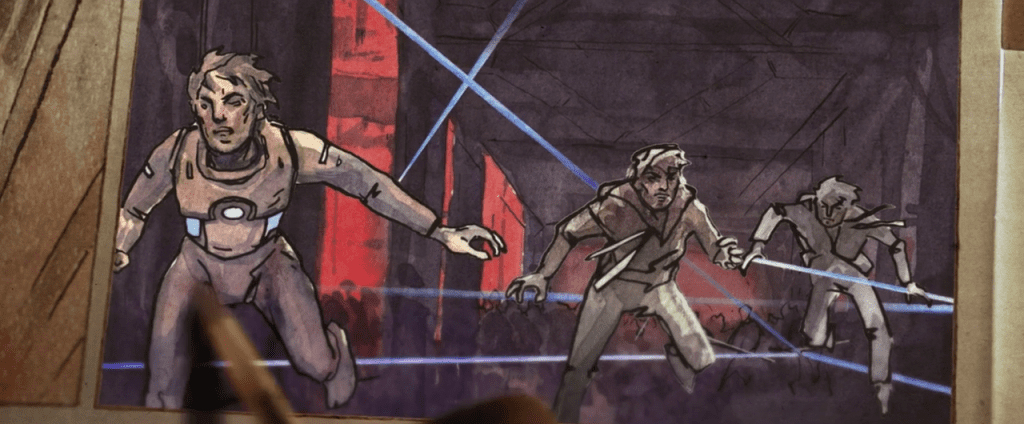Laser Light Art
Most laser shows involve moving beams synchronized to music. We’ve been working with a different approach: creating sculptural art forms in space using static geometric patterns. These installations produce hologram-like structures that performers can interact with and cameras capture with striking clarity.
Laser Light as Sculture
We recently completed a film commercial for Nestle that required creating an underground art installation in an abandoned warehouse on a construction site. The raw concrete and industrial atmosphere provided the backdrop for something completely different from typical laser work. The director wanted static light sculptures that would function as actual set pieces while dancers in LED suits moved through the space. This reversed our usual approach, where movement and music drive everything. The contrast worked perfectly. Rough concrete walls and construction dust, then these precise geometric light forms floating in the middle of it all.

Building Light in Mid-Air
We positioned full-color custom-built lasers throughout the venue, but the real work happened with strategic mirror placement. The mirrors redirected laser beams into triangular patterns that appeared suspended in space, creating convincing geometric structures made entirely of light. We modeled everything in Cinema 4D before implementation. With film crews and dancers moving through laser beam paths, you need to know exactly what you’re building before you start. The two-day night shoot required two senior technicians and two assistants to execute the full installation.

The Technical Reality
Safety shaped every decision. When performers move directly through laser beams, eye injury becomes a real concern. We mapped every beam trajectory and established safe zones throughout the performance area. Balancing laser brightness against film lighting was the biggest technical challenge. Those film lights are incredibly bright, so getting the exposure right took most of the first night. Too dim and the sculptures disappear on camera. Too bright and they overwhelm everything else. Wind complicated things further. We needed a dedicated team just for haze management because atmospheric effects are crucial for making laser beams visible. Without particles in the air, you have no sculpture.
What Made This Work
This project departed completely from conventional laser work that emphasizes movement and music. The underground art context needed something more like installation art, where the laser sculptures served as architectural elements. Performers could physically interact with triangular planes of colored light. This created an interesting relationship between human movement and static light architecture that we hadn’t explored before.

Results
The installation achieved exactly what the director envisioned. Both Nestle and the creative team were pleased with the final piece, which captured the intended contrast between industrial space and refined light sculpture. The project proved that laser effects can create convincing three-dimensional forms that function as legitimate set pieces for the film industry. These geometric structures had enough visual presence to define spaces within the warehouse environment. Take a look at the photos to see how effectively the triangular patterns appeared to float in mid-air.
Creating Walls of Light
The warehouse installation showed us what’s possible when you treat lasers as sculptural tools rather than entertainment effects. We created what looked like solid geometric structures suspended in space, indistinguishable from physical set pieces in their impact on the overall composition. The static patterns proved crucial. By maintaining consistent forms throughout the performance, the light sculptures established spatial boundaries and created defined zones that the dancers could work with and around.
Frequently Asked Questions
How much planning does a laser sculpture project require?
The Nestle project took weeks of design development and 3D modeling before implementation. Complex installations need extensive preparation to coordinate safety requirements and technical specifications.
Is it safe for performers to interact with laser installations?
With proper protocols, yes. We establish comprehensive safety measures for beam path control and power management. Trained technicians monitor all interactions throughout the performance.
Do these installations work outdoors?
Indoor or sheltered locations work best. Wind disrupts the atmospheric effects necessary for beam visibility, making outdoor installations technically challenging.
How do you make laser beams appear solid on camera?
Controlled haze creates the particle density necessary for beam visibility. The balance is critical—too little and beams disappear, too much and everything becomes muddy.
What distinguishes laser sculptures from regular laser shows?
Laser sculpture work focuses on static geometric forms that function as architectural elements. This differs fundamentally from entertainment lighting, requiring different technical approaches and aesthetic considerations.